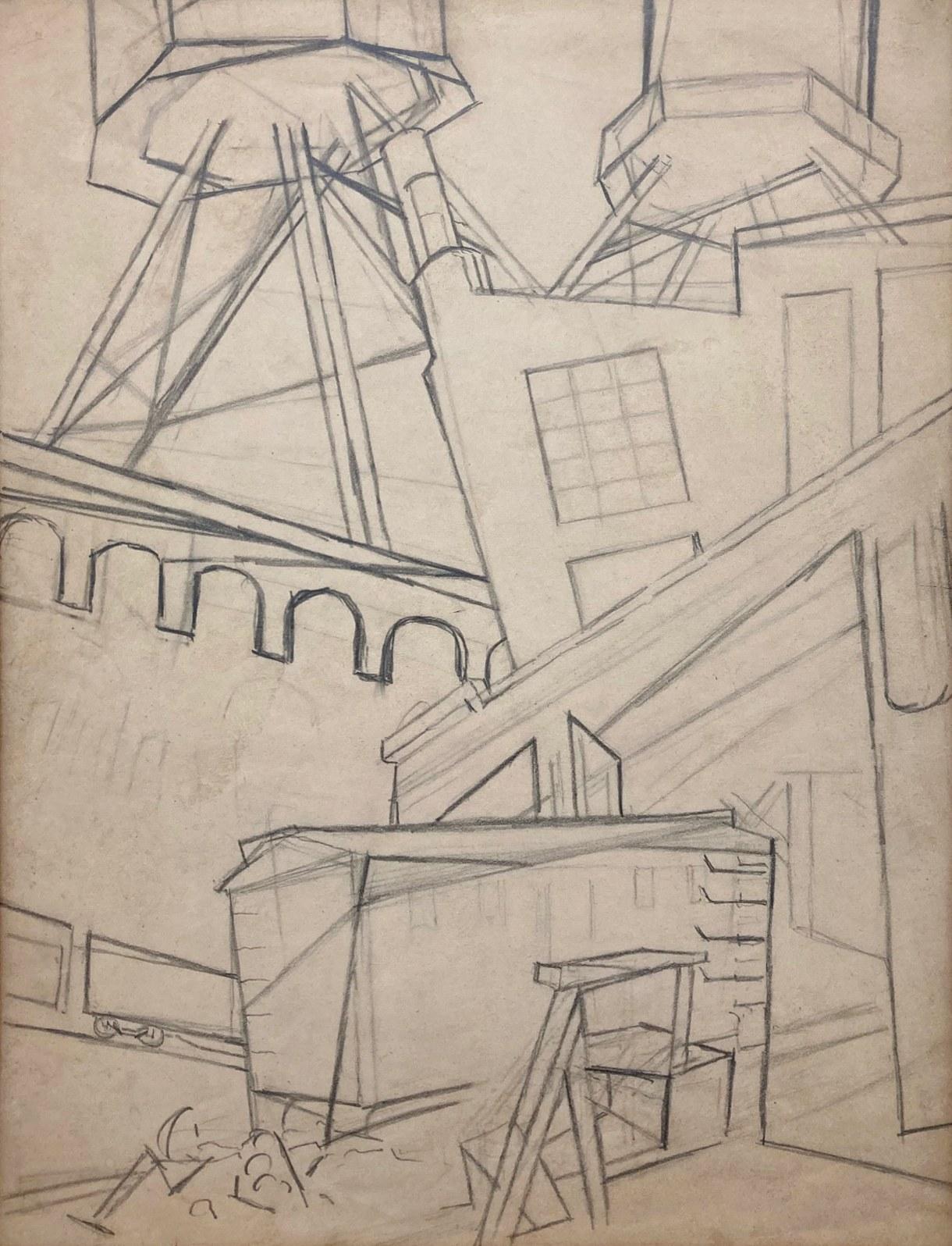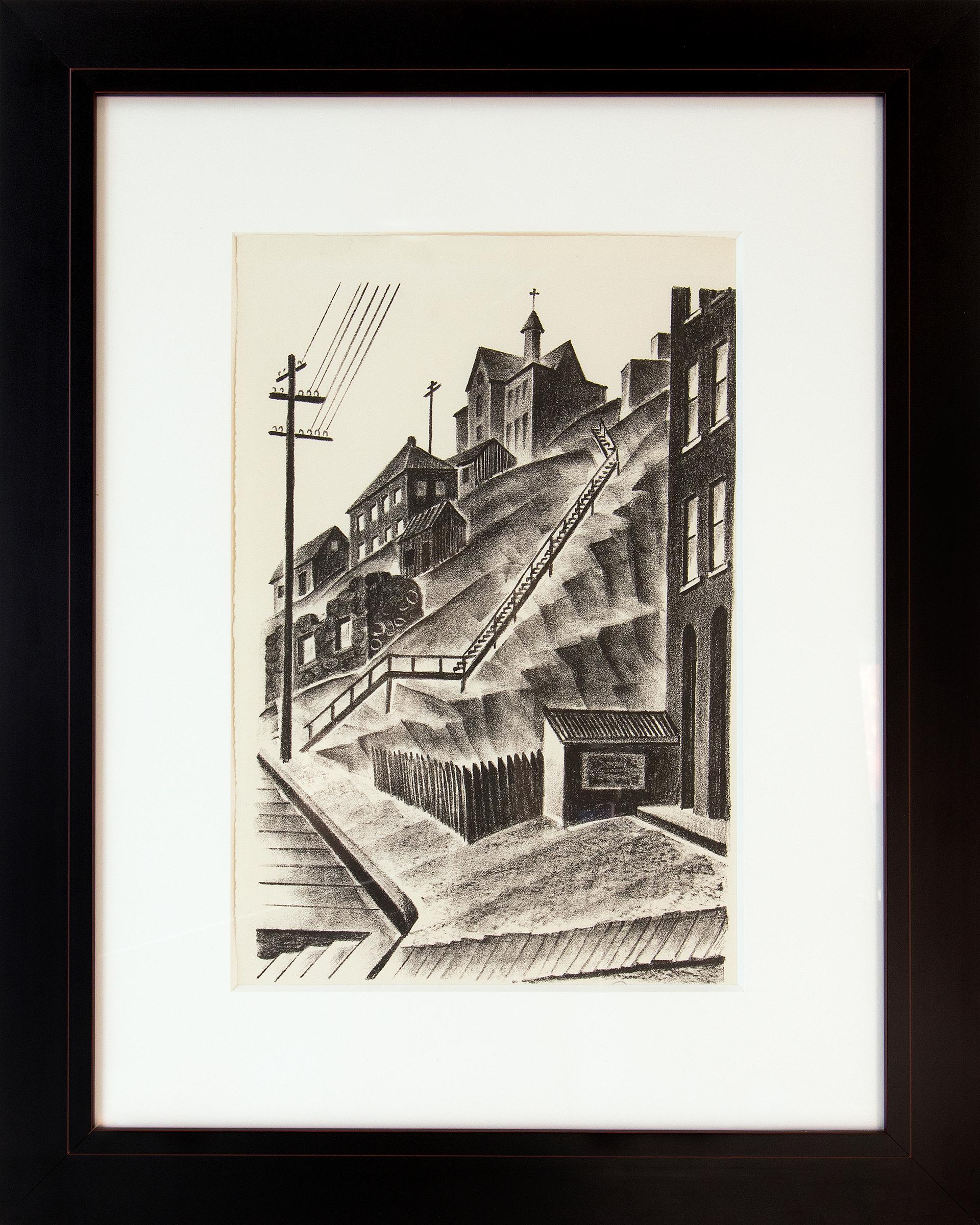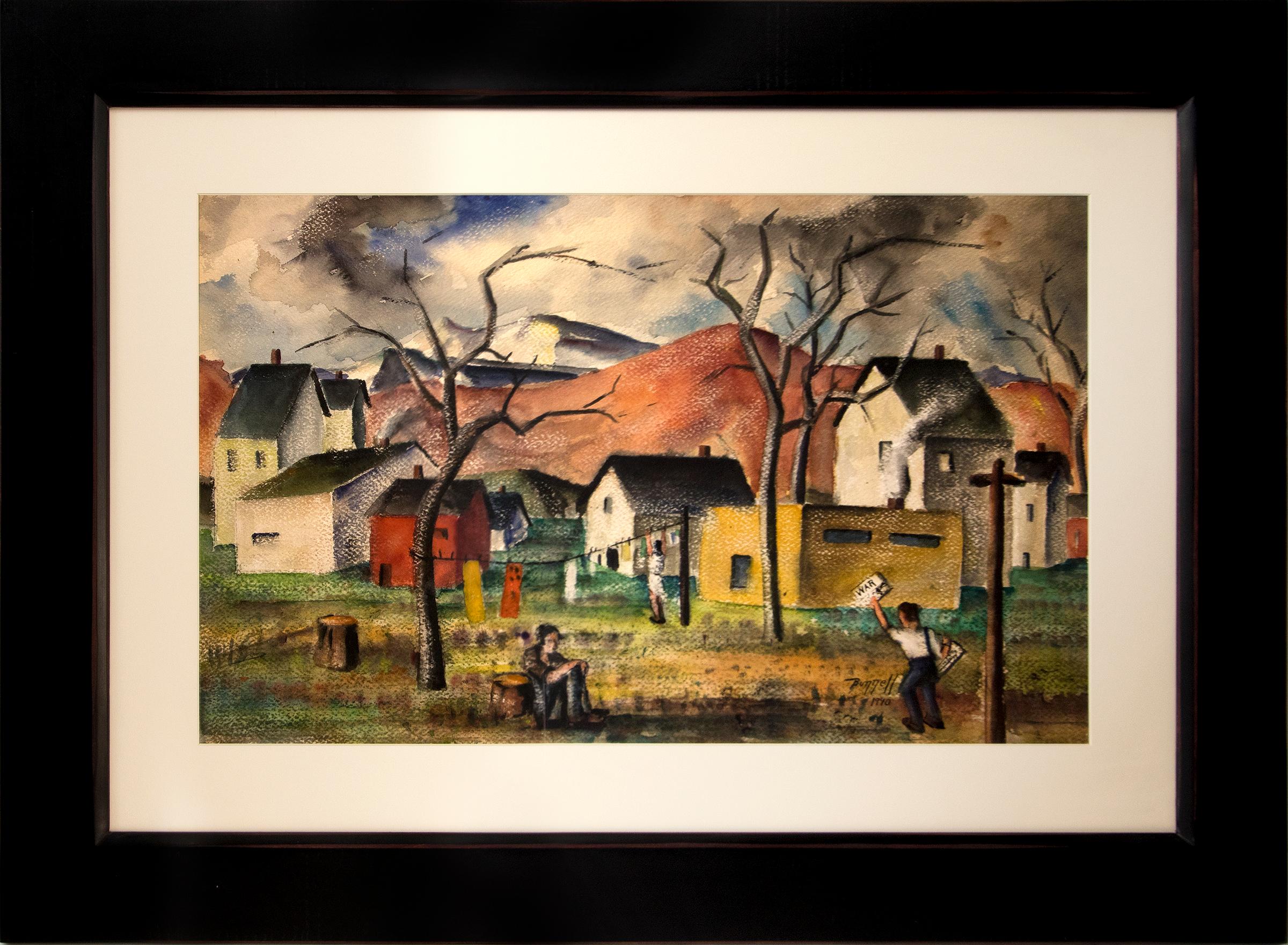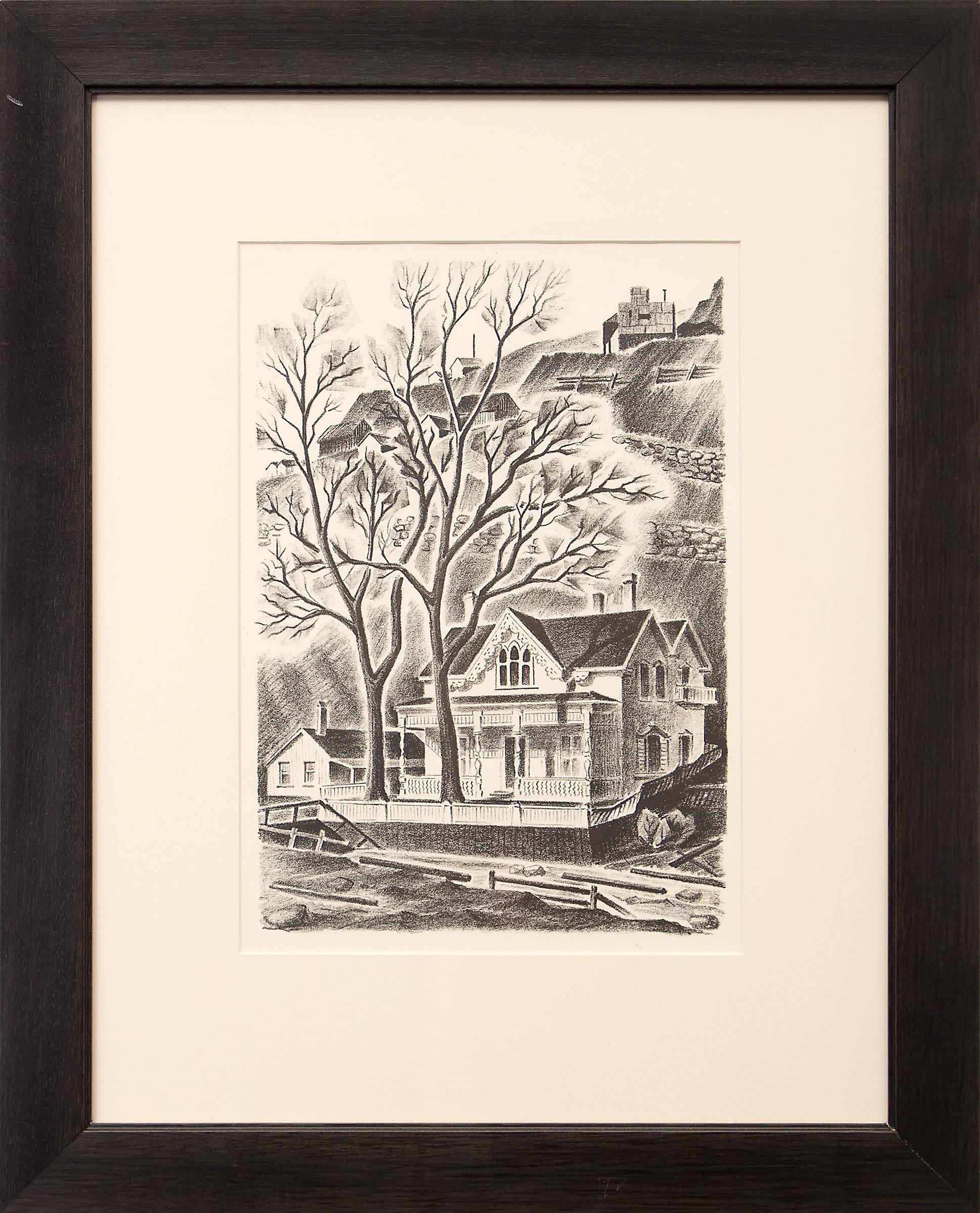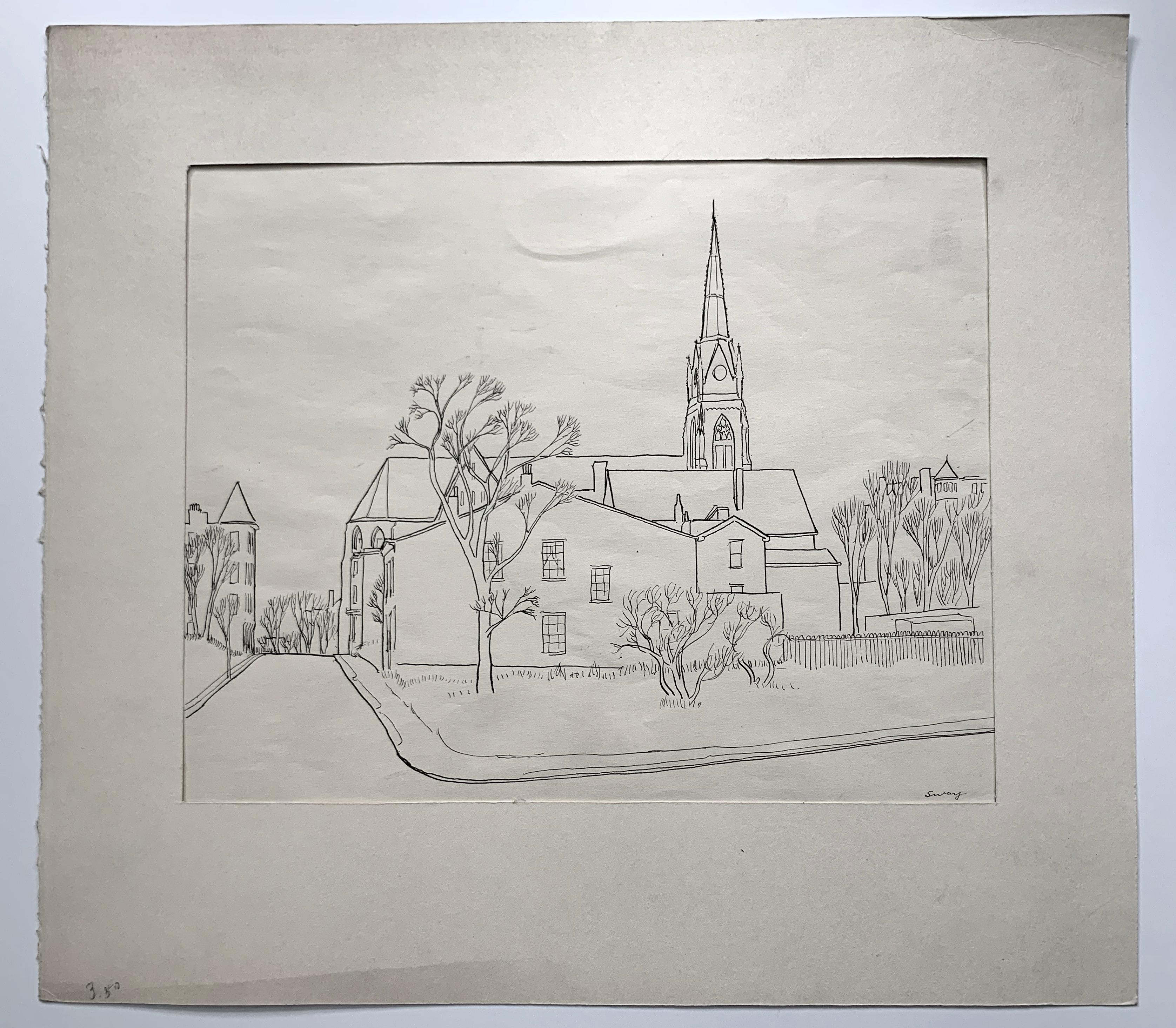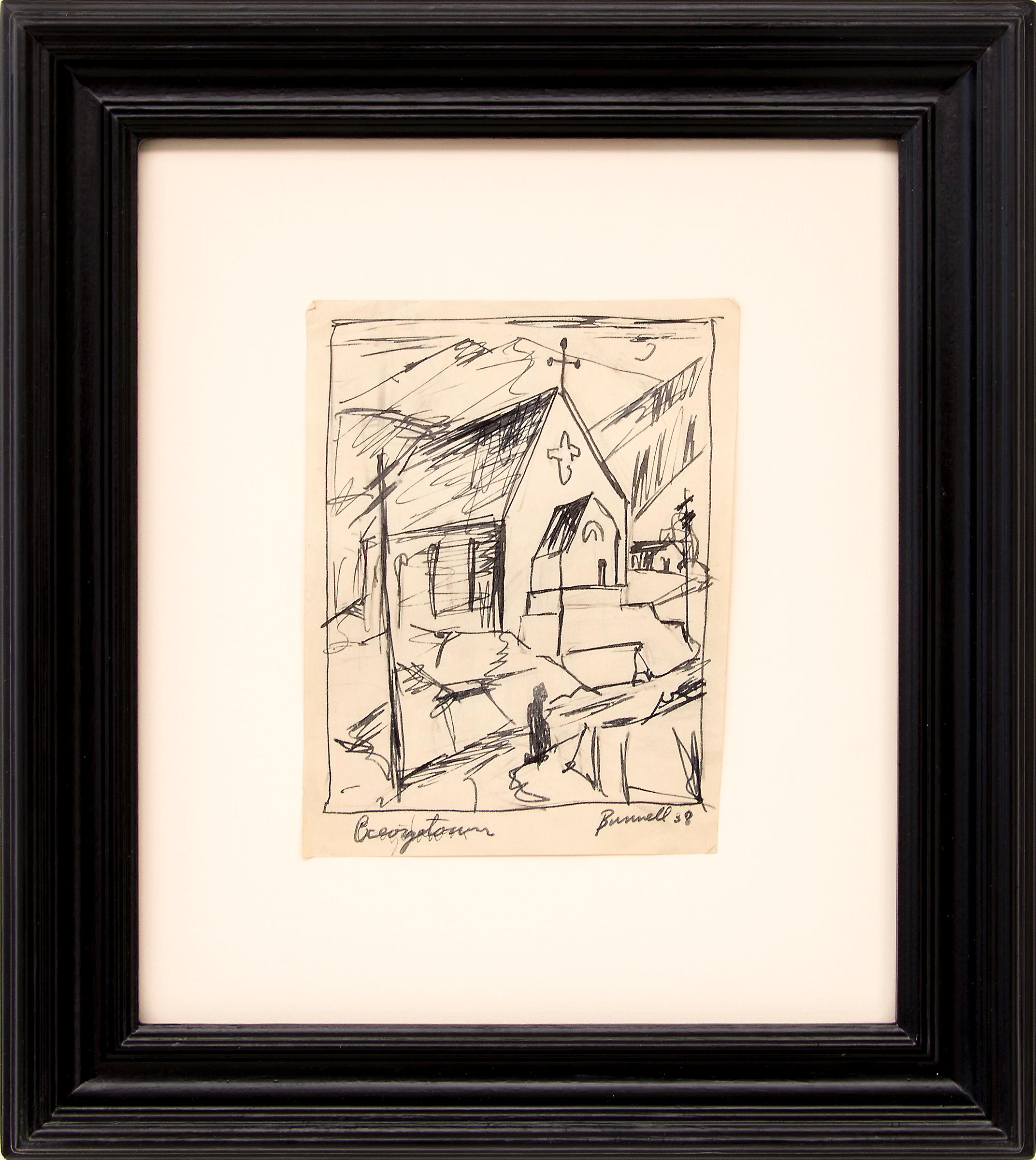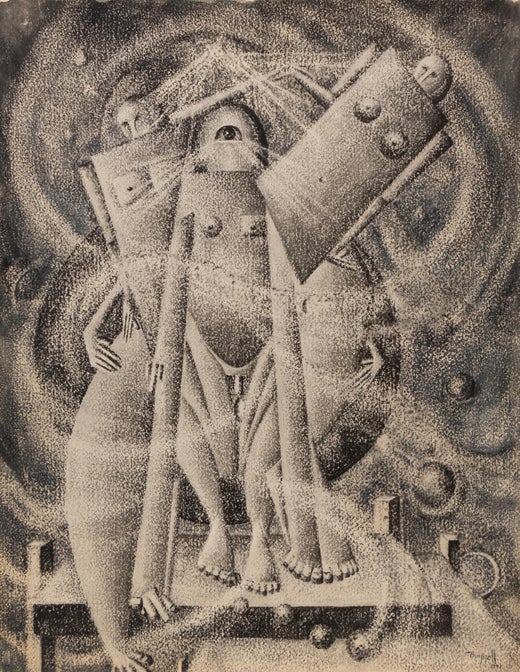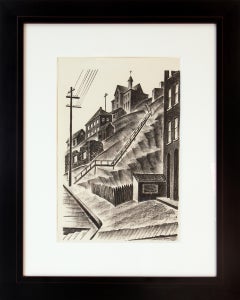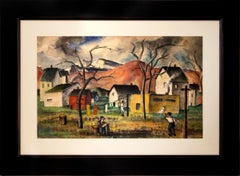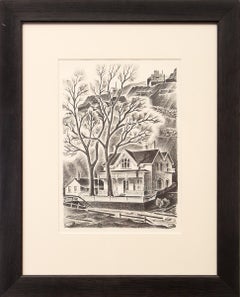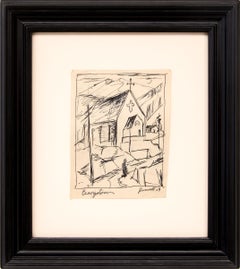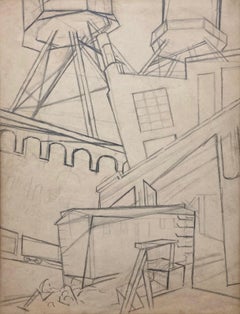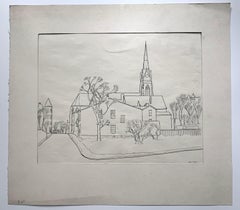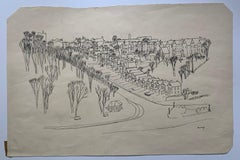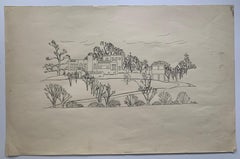Items Similar to 1930s WPA Era Graphite Drawing, American Modern City Scene of Houses on Hill, CO
Video Loading
Want more images or videos?
Request additional images or videos from the seller
1 of 18
Charles Ragland Bunnell1930s WPA Era Graphite Drawing, American Modern City Scene of Houses on Hill, COcirca 1935
circa 1935
$2,750
£2,111.74
€2,422.49
CA$3,864.07
A$4,327.52
CHF 2,258.03
MX$52,858.77
NOK 28,728.68
SEK 27,080.23
DKK 18,078.77
About the Item
Graphite on paper drawing by Charles Ragland Bunnell (1897–1968), circa 1935, featuring a modernist cityscape of houses on a hill in Colorado. This artwork, created during the 1930s WPA era, captures the essence of American modernism. The piece is presented in a custom hardwood frame with archival materials and UV-protectant glass, measuring 21 x 21 ½ x ½ inches, with the image size at 22 x 25 ¾ inches.
Provenance: Estate of the artist, Charles Ragland Bunnell. The drawing is in excellent vintage condition, and a detailed condition report is available upon request.
About the Artist:
Charles Bunnell was an artist and teacher known for his wide range of artistic styles. He worked in both representational and abstract imagery, incorporating the emerging modernist trends from New York and Europe. Bunnell’s style evolved over his lifetime, influenced by the significant cultural shifts of his time, including his experiences with the WPA and his association with artists like Boardman Robinson and Ernest Lawson. He was also an advocate for abstract expressionism, notably introducing Colorado Springs to this style in the late 1940s.
Bunnell’s artistic journey was deeply personal, shaped by both professional challenges and personal tragedies, such as the loss of his son in 1938. His early works often depicted Colorado’s landscapes and mining towns, but by the 1940s, his art had begun to reflect surrealism and transcendental themes.
Throughout his career, Bunnell exhibited widely, with solo shows at major institutions like the New Mexico Museum of Art and the University of Illinois. His work is held in collections at various museums, and he was a beloved instructor, mentoring numerous artists in his Colorado Springs studio until his passing in 1968.
- Creator:Charles Ragland Bunnell (1897-1968, American)
- Creation Year:circa 1935
- Dimensions:Height: 21 in (53.34 cm)Width: 21.5 in (54.61 cm)Depth: 0.5 in (1.27 cm)
- Medium:
- Movement & Style:
- Period:
- Framing:Frame IncludedFraming Options Available
- Condition:Very good to excellent vintage condition. Detailed condition report available upon request.
- Gallery Location:Denver, CO
- Reference Number:Seller: 134811stDibs: LU27312493462
Charles Ragland Bunnell
Charles Bunnell developed a love for art at a very young age. As a child in Kansas City, Missouri, he spent much of his time drawing. When he was unable to find paper he drew on walls and in the margins of textbooks for which he was often fined. Around 1915, Bunnell moved with his family to Colorado Springs, Colorado. He served in World War I and later used his GI Training to study at the Broadmoor Art Academy (later renamed the Colorado Springs Fine Arts Center) during 1922 and 1923. In 1922, he married fellow student, Laura Palmer. He studied with Ernest Lawson in 1927-1928 and, in the winter of 1928-1929, he served as Lawson’s assistant. In the late 1920’s, the Bunnell’s settled just west of Colorado Springs and 1928, they welcomed the first of their three children. Their one-acre homesite, which they referred to as “Old Home Place”, was situated between two sets of railroad tracks at the foot of Pike’s Peak. Charlie converted an old railroad boxcar into his studio, where he later gave lessons. Beginning in 1931, Bunnell spent a year and a half studying under Boardman Robinson. The two men clashed constantly due to a generation gap and markedly different philosophies. Robinson encouraged his students not to stray from realism and though Bunnell mastered Robinson’s preferred style of American Scene painting, he regularly irritated his professor with his abstract sketches. Bunnell taught at the Kansas City Art Institute during the summers of 1929, 1930, 1940, and 1941. Between 1934 and 1941, he painted and taught under federal projects which included assisting Frank Mechau on murals for the Colorado Springs Post Office. However, he did not take to mural making and, after criticism from Boardman Robinson about his use of “heavy daubs which have no place in mural work,” he abandoned mural-making altogether. By the late 1930’s, Bunnell’s work departed from the American Scene/Modernist style he was trained in towards abstraction. This is marked by his “Black and Blue” series, consisting of 83 abstracted ink and watercolors. Affected by the Second World War and the loss of his 10-year old son, Bunnell’s work of the early 1940’s took on a Transcendental and Surrealist tone. The works from this period are moody and readily reflect the political and personal turmoil experienced by the artist. In the late 1940’s, Bunnell began experimenting with Abstract Expressionism. He alone is credited with introducing Colorado Springs to the new style as it was excluded from the Fine Art Center’s curriculum by Boardman Robinson. Bunnell excelled in Abstract Expressionism and continued to evolve in the style through the 1950’s continuing to his death in 1968. He was recently recognized as a premier American Abstract Expressionist by his inclusion in the book American Abstract Expressionism of the 1950’s: An Illustrated Survey. © David Cook Galleries, LLC
About the Seller
5.0
Gold Seller
Premium sellers maintaining a 4.3+ rating and 24-hour response times
Established in 1979
1stDibs seller since 2013
291 sales on 1stDibs
Typical response time: 11 hours
- ShippingRetrieving quote...Shipping from: Denver, CO
- Return Policy
Authenticity Guarantee
In the unlikely event there’s an issue with an item’s authenticity, contact us within 1 year for a full refund. DetailsMoney-Back Guarantee
If your item is not as described, is damaged in transit, or does not arrive, contact us within 7 days for a full refund. Details24-Hour Cancellation
You have a 24-hour grace period in which to reconsider your purchase, with no questions asked.Vetted Professional Sellers
Our world-class sellers must adhere to strict standards for service and quality, maintaining the integrity of our listings.Price-Match Guarantee
If you find that a seller listed the same item for a lower price elsewhere, we’ll match it.Trusted Global Delivery
Our best-in-class carrier network provides specialized shipping options worldwide, including custom delivery.More From This Seller
View AllWPA-Era Central City, Colorado, 1930s Modernist Lithograph, Cityscape 3/25
By Arnold Rönnebeck
Located in Denver, CO
This 1933 lithograph, Central City, Colorado 3/25, by Arnold Rönnebeck, captures the architectural essence of a historic mining town during the Great Depression. Rendered in black an...
Category
1930s American Modern Figurative Prints
Materials
Lithograph
$1,350 Sale Price
50% Off
WPA 1940s Framed Figurative Village Landscape with Figures, Houses & Mountains
By Charles Ragland Bunnell
Located in Denver, CO
This evocative watercolor painting, titled The Way War First Comes (1940), was created by noted American artist Charles Ragland Bunnell (1897-1968) during the Depression era. The pie...
Category
1940s American Modern Figurative Drawings and Watercolors
Materials
Watercolor
Arnold Ronnebeck Lithograph of Gregory Point, Colorado, 1930s Modernist Print
By Arnold Rönnebeck
Located in Denver, CO
This original 1930s lithograph by renowned modernist artist Arnold Ronnebeck (1885–1947) captures a historic home at Gregory Point, near Central City, Colorado. Part of a limited edi...
Category
1930s American Modern Landscape Prints
Materials
Lithograph, Paper
Georgetown, Colorado, 1938 WPA Era Ink Drawing of Rocky Mountain Landscape
By Charles Ragland Bunnell
Located in Denver, CO
This vintage 1938 ink drawing by Charles Bunnell (1897–1968) captures a stunning scene of a church nestled in the majestic Rocky Mountains of Georgetown, Colorado. Executed in bold black ink on creamy white paper, the piece is signed and dated by the artist in the lower right and titled in the lower left. The image size is 7 ¾ x 5 ¾ inches, and it is framed with archival materials, with outer dimensions measuring 16 ¼ x 14 ½ x 1 ¼ inches.
Condition:
The drawing is in good vintage condition, with no notable flaws. For a detailed condition report, please contact us directly.
Provenance:
This artwork comes from the estate of Charles Ragland Bunnell, ensuring its authenticity.
About Charles Bunnell:
Charles Bunnell was a prominent American artist whose career spanned multiple styles and influences. Born in Kansas City, Missouri, he moved to Colorado Springs around 1915, where he developed a love for art. After serving in World War I, Bunnell studied at the Broadmoor Art Academy (later renamed the Colorado Springs Fine Arts Center), where he met his wife, Laura Palmer...
Category
1930s American Modern Landscape Drawings and Watercolors
Materials
Ink
1950s Denver Skyline Painting – Graphite & Watercolor Colorado Cityscape Art
Located in Denver, CO
A captivating midcentury cityscape titled "Denver Skyline", this original 1950s watercolor and graphite painting offers a rare industrial-era view of lower downtown Denver, Colorado....
Category
1950s American Impressionist Landscape Paintings
Materials
Watercolor, Graphite
1940s WPA-Era Abstract Watercolor of Golden Cycle Mill by Charles Ragland Bunnel
By Charles Ragland Bunnell
Located in Denver, CO
This original 1940s grayscale watercolor by Charles Ragland Bunnell captures a semi-abstracted view of the Golden Cycle Mill in Colorado Springs, Colorado. Rendered in subtle blacks and grays, this striking WPA-era landscape melds industrial subject matter with a modernist aesthetic. The piece exemplifies mid-20th-century American regionalism, blending expressive abstraction with historical significance.
The painting measures 8 1/8 x 9 5/8 inches (sight size) and is showcased in a custom black frame measuring 18 x 19 ½ x 1 ⅜ inches, making it an elegant addition to any collection of American art or industrial landscapes.
The Golden Cycle Mining and Reduction Company was a vital part of Colorado’s early 20th-century mining boom, located in what is now Old Colorado City. Bunnell’s work documents this industrial heritage through a modernist lens, offering a unique narrative of regional development.
About the Artist:
Charles Ragland Bunnell (1897–1968) was a key figure in Colorado’s art scene and a pioneer of American Modernism and abstraction. Trained at Broadmoor Art Academy, he combined American Scene painting with abstract forms. Bunnell contributed to New Deal art...
Category
1940s American Modern Landscape Paintings
Materials
Watercolor
You May Also Like
A ca. 1940s Graphite on Paper Mural Study of a City Scene by Rudolph Weisenborn
By Rudolph Weisenborn
Located in Chicago, IL
A ca. 1940s graphite on paper mural study of a Chicago city scene by notable Modern artist Rudolph Weisenborn. Artwork size: 12 1/2" x 9 1/4". Archivally matted to 18" x 16". Provenance: Estate of the artist.
Rudolph Weisenborn was born in Strassburg, Germany in 1881, but was orphaned at the age of nine. He was taken-in by Mid-Western farmer Thomas Westaby and spent his early years in Wisconsin, Iowa and North Dakota. Weisenborn first attended the University of North Dakota in 1898, then the Students School of Art in Denver. Various accounts have him working out west as a gold miner and cowboy.
Around 1912, he settled in Chicago and worked as a window designer for Marshall Field’s. Weisenborn is best known as the founder of the Chicago No-Jury Society of Artists. The group was founded because many artists could not get their work accepted into the mainstream Art Institute shows. Weisenborn is quoted as saying that he harbored feelings of disdain for any jury and that his own paintings were frequently rejected by conservative jurors. He was also involved and helped found other radical artist’s groups such as the Salon des Refuses, Cor Ardens and Neo-Arlimusic. In 1936, he helped found the New York-based American Abstract Artist’s Group. He created the only abstract mural for the 1933 Century of Progress Exhibition in Chicago and also worked for the Federal Arts Project in the Easel Division. His WPA murals can be found in Crane Technical High School and Nettlehorst Elementary School in Chicago, IL. In 1945, Chicago businessman Herman Spertus...
Category
1940s American Modern Landscape Drawings and Watercolors
Materials
Paper, Graphite
Cincinnati Ohio cityscape drawing WPA era
Located in Wilton Manors, FL
Beautiful original drawing by American artist, Albert Sway (b.1913). Cincinnati Cityscape, ca. 1935. Ink on paper measures 9.5 x 12 inches. Signed lower right. Good condition with no...
Category
1930s American Realist Landscape Drawings and Watercolors
Materials
Paper, Ink
Cincinnati Ohio cityscape drawing WPA era
Located in Wilton Manors, FL
Beautiful original drawing by American artist, Albert Sway (b.1913). Cincinnati Cityscape, ca. 1935. Ink on paper measures 10 x 15 inches. Signed lower left. Good condition with no d...
Category
1930s American Realist Landscape Drawings and Watercolors
Materials
Paper, Ink
Cincinnati Ohio cityscape drawing WPA era
Located in Wilton Manors, FL
Beautiful original drawing by American artist, Albert Sway (b.1913). Cincinnati Cityscape, ca. 1935. Ink on paper measures 11 x 17 inches. Signed lower right. Good condition with no ...
Category
1930s American Realist Landscape Drawings and Watercolors
Materials
Paper, Ink
Cincinnati Ohio cityscape drawing WPA era
Located in Wilton Manors, FL
Beautiful original drawing by American artist, Albert Sway (b.1913). Cincinnati Cityscape, ca. 1935. Ink on paper measures, sheet measures 11 x 17 inches. Signed lower right. No da...
Category
1930s American Realist Landscape Drawings and Watercolors
Materials
Paper, Ink
Cincinnati Ohio cityscape drawing WPA era
Located in Wilton Manors, FL
Beautiful original drawing by American artist, Albert Sway (b.1913). Cincinnati Cityscape, ca. 1935. Ink on paper measures 11 x 17 inches. Signed lower right. Good condition with a 1...
Category
1930s American Realist Landscape Drawings and Watercolors
Materials
Paper, Ink
More Ways To Browse
Drawing Of A House
Vintage Painting Of European Cities
Wpa Era Paintings
Wpa Art Charles
Vintage Lawson
Arthur Severn
Augustus Spencer Paintings
E Ambrose Webster
Jane Lampard
Joseph Kirkpatrick
Louis Vuitton Aix En Provence
Nachshon Lithograph
Recto Verso Louis Vuitton
Wayne Wolfe
Wim Oepts
Colin Moss
Dahlov Ipcar
Daisy Simon
